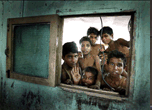
An effort pioneered in India to organise a formal bank for street children and run by children themselves is now spreading across India and the world. For just over 3 years, Children’s Development Bank [CDB] aka Bal Vikas Bank, has been running in Delhi. It serves 300 street children through 2 branches and 4 collection centres. CDB is an innovation of Butterflies, an organisation that works with children living by their wits, on their own. Rita Panicker who heads Butterflies, was first struck by the pluck and fortitude of these kids making a fist of life on Mumbai’s commuter trains. She fell in love with them and when she moved to Delhi in the late eighties, she was automatically drawn to Delhi’s own street children. Butterflies began its work in 1988.
Their strategy is to have trained volunteers patrol the streets and look for street children in trouble. There are many hazards these children are subject to. Their horrors come in the form of drugs, sex, police and thugs. Befriending them and getting them to trust is hard, but once they are won over, it is always heartbreaking to see the optimism and zest they have for life despite hardships. They rarely ask for handouts and are ready to face the odds.
Over the years Butterflies, has intervened in the case of 25,000 children. Relationships have been for varying lengths of time. “Our first endeavour is always to help them go back home,” says Rita. There has even been a case of a lad sent back, with an escort, to his family in Bangladesh. But quite often, children’s memory of unhappiness and physical abuse is so extreme that they opt for a life on the streets. For these, Butterflies provides a focal point. They induct them into education by whatever means that is appropriate—casual, formal and distance. Children have counsellors they can turn to, a place where they can get a subsidised meal and a shelter for the night.
Efforts are paying off. Today Butterflies has 4 shelters in Delhi. Hundreds of children are getting some education and six have enrolled in the Indira Gandhi National Open University. 48 of them are true alumni, having spent most of their first 18 years of life with Butterflies. Two of them are also street educators. A few are married and content with life. In April, 2001 when funding became available for starting a Youth Bank modelled after the one in the UK, Rita discussed it with children at the shelter. They showed they had a mind of their own: they wanted to start and run a bank exclusively for children. Thus began the exciting new adventure with backing from various donor agencies—Comic Relief, UK, the Ford Foundation, USA and Misereor, Germany and the Ministry of Social Justice, India. About 300 children account holders/members deposit cash saved from their earnings. 20% of this is loaned out to members for sound business ideas, as long as they have two guarantors. A part of the profit from interest is paid out and the other part rolled into the capital. The bank has two full time managers and a street canvasser promoting the idea among non-members.
It turned out that the greatest relief for children was that there was somewhere they could safe-keep their money. Often they just spent it all, lest the police or pick-pockets should relieve them of it. The bank also has a strict rule of not advancing loans to adults: very often estranged parents show up when they learn their child has put away some money. Borrowers from CDB have also to fulfil the condition that they continue their education. Life at the shelters is friendly but also disciplined. Children have pooled in and bought themselves a TV and a DVD player, but it is switched off when its time to study or sleep. They run a community kitchen and give themselves inexpensive, nutritious meals. And many have taken to catering as a business. Shelters are for boys only. Rita says that the majority of run-aways are boys. Girls do roam the streets but each invariably returns to a home of sorts. Girls are however, account holders in CDB.
The idea has caught on. The Delhi CDB is a lab from where a replicable model has evolved, complete with registers, passbooks, ID cards and an operation manual. They also impart training and send start up teams. So far there are CDB – Bal Vikas Banks – in Muzaffarpur, Bihar, Chennai, Kolkata and Leh, in J&K. CDB has also helped begin similar banks in Nepal and Bangladesh. One is coming up in Afghanistan. Next year, Sri Lanka and Pakistan will join the network. There are enquiries from Iran, Sudan and Central Asia.
Rita has clearly kept her date with those kids she first saw on Mumbai’s trains and fell in love with.
(Published with kind permission of www.goodnewsindia.com where you will find many positive stories on India.)





